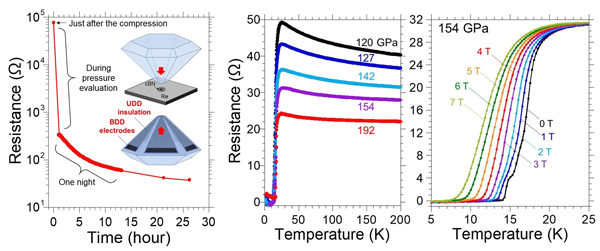PC2-4
Electrical measurements for superconducting hydrides using diamond anvil cell with boron-doped diamond electrodes
Dec.1 14:15-14:30 (Tokyo Time)
National Institute for Materials Science, Japan1
Osaka University, Japan2
Kyoto University of Advanced Science, Japan3
University of Tsukuba, Japan4
Ehime University, Japan5
Recently, several high-Tc superconducting hydrides were discovered via high-pressure experiments above 100 GPa, for example, H3S [1], LaH10 [2], and YH9 [3]. Theoretical prediction suggests superconductivity at 473 K udner 250 GPa in ternary hydride Li2MgH16 [4]. However, the synthesis and electrical measurements for such hydrides are technically difficult because of a hydrogen sealing and preparation of micro-electrodes into a tiny sample chamber of diamond anvil cell (DAC). In this presentation, our originally designed DAC with boron-doped diamond electrodes and undoped diamond insulating layer for synthesis and measurements of superconducting hydrides will be introduced. As a test experiment, we tried to synthesis for superconducting sulfur hydrides and observed the Tc at around 25 K under 120 GPa [5].
[1] A. P. Drozdov et al., Nature 525, 73 (2015).
[2] M. Somayazulu et al., Phys. Rev. Lett. 122, 027001 (2019).
[3] P. P. Kong et al., arXiv:1909.10482 (2019).
[4] Y. Sun et al., Phys. Rev. Lett. 123, 097001 (2019).
[5] R. Matsumoto et al., arXiv:2006.09671 (2020).
Figure :R-T properties under high pressures for compressed sulfur hydrides.
Keywords: Diamond Anvil Cell, High Pressure, Hydride
